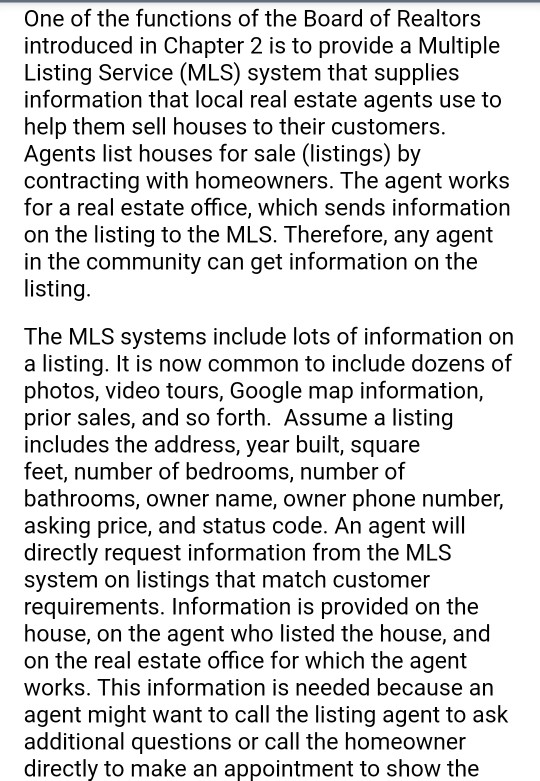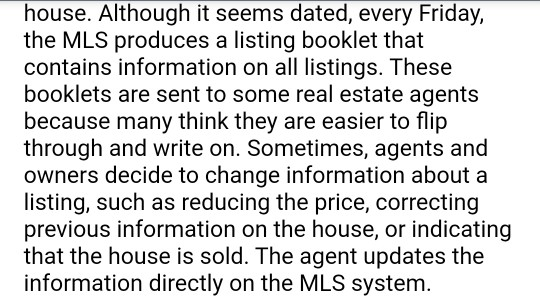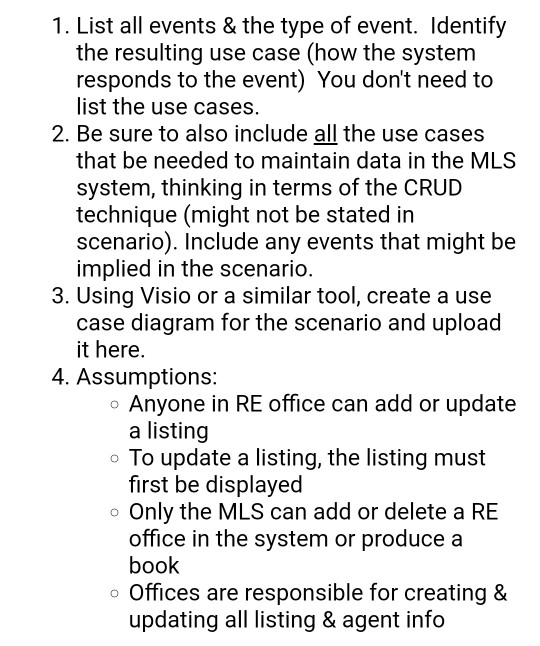Answered step by step
Verified Expert Solution
Question
1 Approved Answer
One of the functions of the Board of Realtors introduced in Chapter 2 is to provide a Multiple Listing Service (MLS) system that supplies information



One of the functions of the Board of Realtors introduced in Chapter 2 is to provide a Multiple Listing Service (MLS) system that supplies information that local real estate agents use to help them sell houses to their customers. Agents list houses for sale (listings) by contracting with homeowners. The agent works for a real estate office, which sends information on the listing to the MLS. Therefore, any agent in the community can get information on the listing. The MLS systems include lots of information on a listing. It is now common to include dozens of photos, video tours, Google map information, prior sales, and so forth. Assume a listing includes the address, year built, square feet, number of bedrooms, number of bathrooms, owner name, owner phone number, asking price, and status code. An agent will directly request information from the MLS system on listings that match customer requirements. Information is provided on the house, on the agent who listed the house, and on the real estate office for which the agent works. This information is needed because an agent might want to call the listing agent to ask additional questions or call the homeowner directly to make an appointment to show the house. Although it seems dated, every Friday, the MLS produces a listing booklet that contains information on all listings. These booklets are sent to some real estate agents because many think they are easier to flip through and write on. Sometimes, agents and owners decide to change information about a listing, such as reducing the price, correcting previous information on the house, or indicating that the house is sold. The agent updates the information directly on the MLS system. 1. List all events & the type of event. Identify the resulting use case (how the system responds to the event) You don't need to list the use cases. 2. Be sure to also include all the use cases that be needed to maintain data in the MLS system, thinking in terms of the CRUD technique (might not be stated in scenario). Include any events that might be implied in the scenario. 3. Using Visio or a similar tool, create a use case diagram for the scenario and upload it here. 4. Assumptions: . Anyone in RE office can add or update a listing To update a listing, the listing must first be displayed . Only the MLS can add or delete a RE office in the system or produce a book . Offices are responsible for creating & updating all listing & agent info One of the functions of the Board of Realtors introduced in Chapter 2 is to provide a Multiple Listing Service (MLS) system that supplies information that local real estate agents use to help them sell houses to their customers. Agents list houses for sale (listings) by contracting with homeowners. The agent works for a real estate office, which sends information on the listing to the MLS. Therefore, any agent in the community can get information on the listing. The MLS systems include lots of information on a listing. It is now common to include dozens of photos, video tours, Google map information, prior sales, and so forth. Assume a listing includes the address, year built, square feet, number of bedrooms, number of bathrooms, owner name, owner phone number, asking price, and status code. An agent will directly request information from the MLS system on listings that match customer requirements. Information is provided on the house, on the agent who listed the house, and on the real estate office for which the agent works. This information is needed because an agent might want to call the listing agent to ask additional questions or call the homeowner directly to make an appointment to show the house. Although it seems dated, every Friday, the MLS produces a listing booklet that contains information on all listings. These booklets are sent to some real estate agents because many think they are easier to flip through and write on. Sometimes, agents and owners decide to change information about a listing, such as reducing the price, correcting previous information on the house, or indicating that the house is sold. The agent updates the information directly on the MLS system. 1. List all events & the type of event. Identify the resulting use case (how the system responds to the event) You don't need to list the use cases. 2. Be sure to also include all the use cases that be needed to maintain data in the MLS system, thinking in terms of the CRUD technique (might not be stated in scenario). Include any events that might be implied in the scenario. 3. Using Visio or a similar tool, create a use case diagram for the scenario and upload it here. 4. Assumptions: . Anyone in RE office can add or update a listing To update a listing, the listing must first be displayed . Only the MLS can add or delete a RE office in the system or produce a book . Offices are responsible for creating & updating all listing & agent info
Step by Step Solution
There are 3 Steps involved in it
Step: 1

Get Instant Access to Expert-Tailored Solutions
See step-by-step solutions with expert insights and AI powered tools for academic success
Step: 2

Step: 3

Ace Your Homework with AI
Get the answers you need in no time with our AI-driven, step-by-step assistance
Get Started


